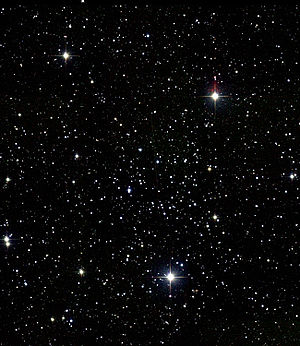Messier 50

|
|
| AladinLite | |
| Constellation | unicorn |
|
Position equinox : J2000.0 |
|
|---|---|
| Right ascension | 07 h 02 m 42.0 s |
| declination | −08 ° 21 ′ 51 ″ |
| Appearance
|
|
| classification | II, 3, m (Trumpler), e (Shapley) |
| Brightness (visual) | 5.9 likes |
| Brightness (B-band) | 6.27 likes |
| Angular expansion | 16 ' |
| Number of stars | 200 |
| Brightest star | 9.0 mag |
| Physical data
|
|
| distance | 3200 ly (1000 pc ) |
| diameter | 20 ly |
| Age | 78 million years |
| history | |
| Discovered by | Giovanni Domenico Cassini |
| Discovery time | 1711 |
| Catalog names | |
| M 50 • NGC 2323 • C 0700-082 • OCl 559 • Mel 58 • Cr 124 • Lund 283 • OCISM 118 | |
Messier 50 (also referred to as NGC 2323 ) is a +5.9 mag bright open star cluster with an angular extent of 16 'in the constellation Unicorn . Its distance to the solar system is about 3000 light years , the total mass is estimated at about 1000 solar masses . At 140 million years old, M 50 is one of the younger galactic star clusters in the Milky Way . Messier 50 was discovered in 1711 by the French astronomer Giovanni Domenico Cassini . On April 5, 1772, Charles Messier observed this open star cluster and added it to his catalog.
A 2012 published, photometric and astrometric study by researchers at the Pulkovo Observatory , based on astrography plates, found a number of 508 cluster members.
Individual evidence
- ↑ NASA / IPAC EXTRAGALACTIC DATABASE
- ↑ a b c d e f g Messier 50 at SEDS
- ↑ a b SIMBAD
- ↑ Courtney Seligman: New General Catalog Objects: NGC 2300 - 2349. Retrieved February 13, 2016 (English).
- ^ VN Frolov, Yu. K. Ananjevskaja, EV Polyakov: Investigation of the Open Star Cluster NGC 2323 (M50) Based on the Proper Motions and Photometry of Its Constituent Stars . In: Astronomy Letters . tape 38 , no. 2 , February 1, 2012, ISSN 1063-7737 , doi : 10.1134 / S106377371202003X ( researchgate.net [accessed July 28, 2016]).

